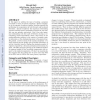1461 search results - page 120 / 293 » Complexity of Graph Covering Problems |
109
click to vote
ANOR
2005
15 years 13 days ago
2005
In Hell et al. (2004), we have previously observed that, in a chordal graph G, the maximum number of independent r-cliques (i.e., of vertex disjoint subgraphs of G, each isomorphic...
78
Voted
LREC
2010
15 years 2 months ago
2010
Evaluating complex Natural Language Processing (NLP) systems can prove extremely difficult. In many cases, the best one can do is to evaluate these systems indirectly, by looking ...
IJCBDD
2010
14 years 11 months ago
2010
: The explosion of highthroughput interaction data from proteomics studies gives us the opportunity to integrate Protein-Protein Interactions (PPI) from different type of interacti...
103
Voted
CIKM
2008
Springer
15 years 2 months ago
2008
Springer
In the past, quite a few fast algorithms have been developed to mine frequent patterns over graph data, with the large spectrum covering many variants of the problem. However, the...
101
Voted
CASES
2009
ACM
14 years 10 months ago
2009
ACM
In this paper we address the issue of making a program reversible in terms of spatial complexity. Spatial complexity is the amount of memory/register locations required for perfor...

